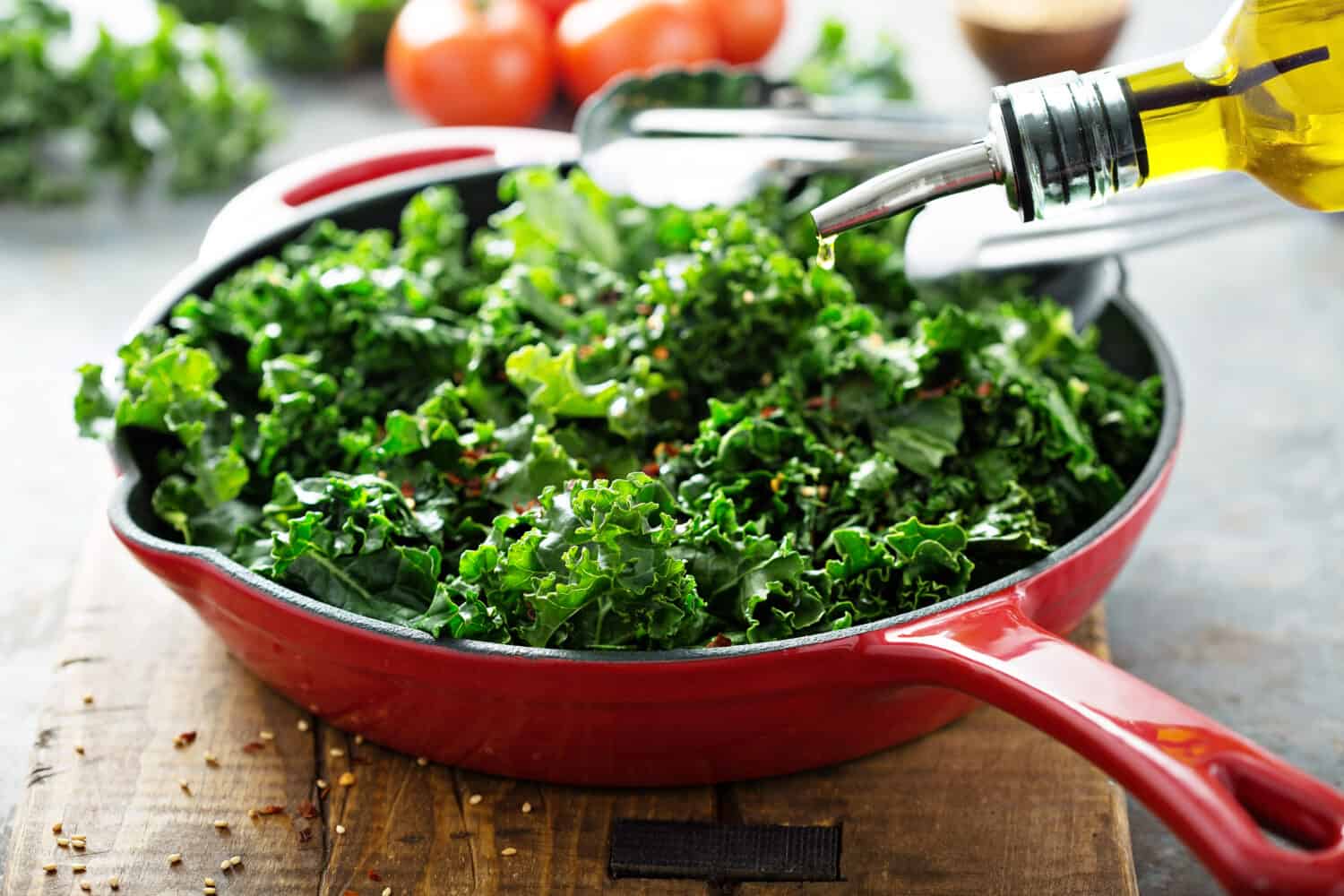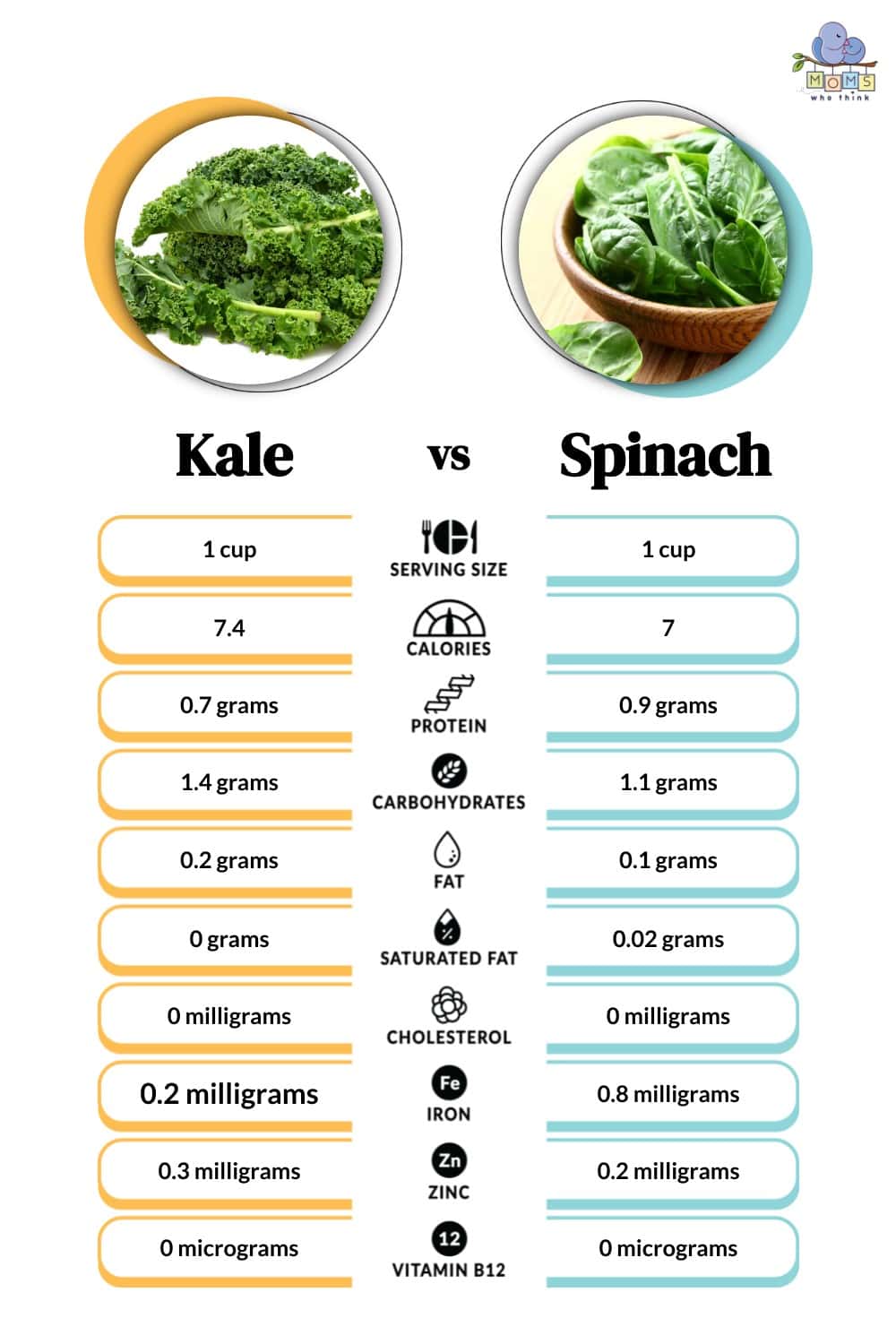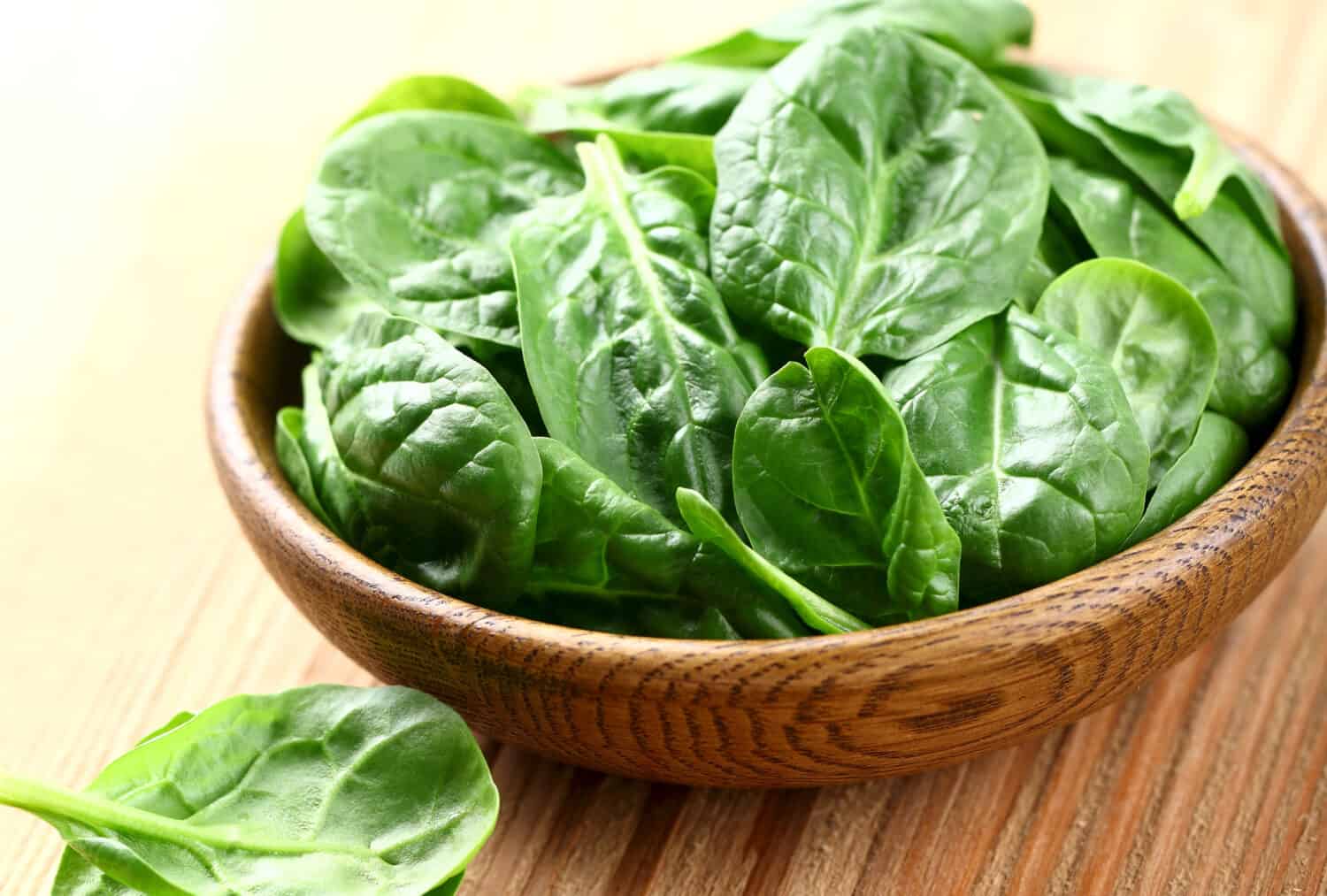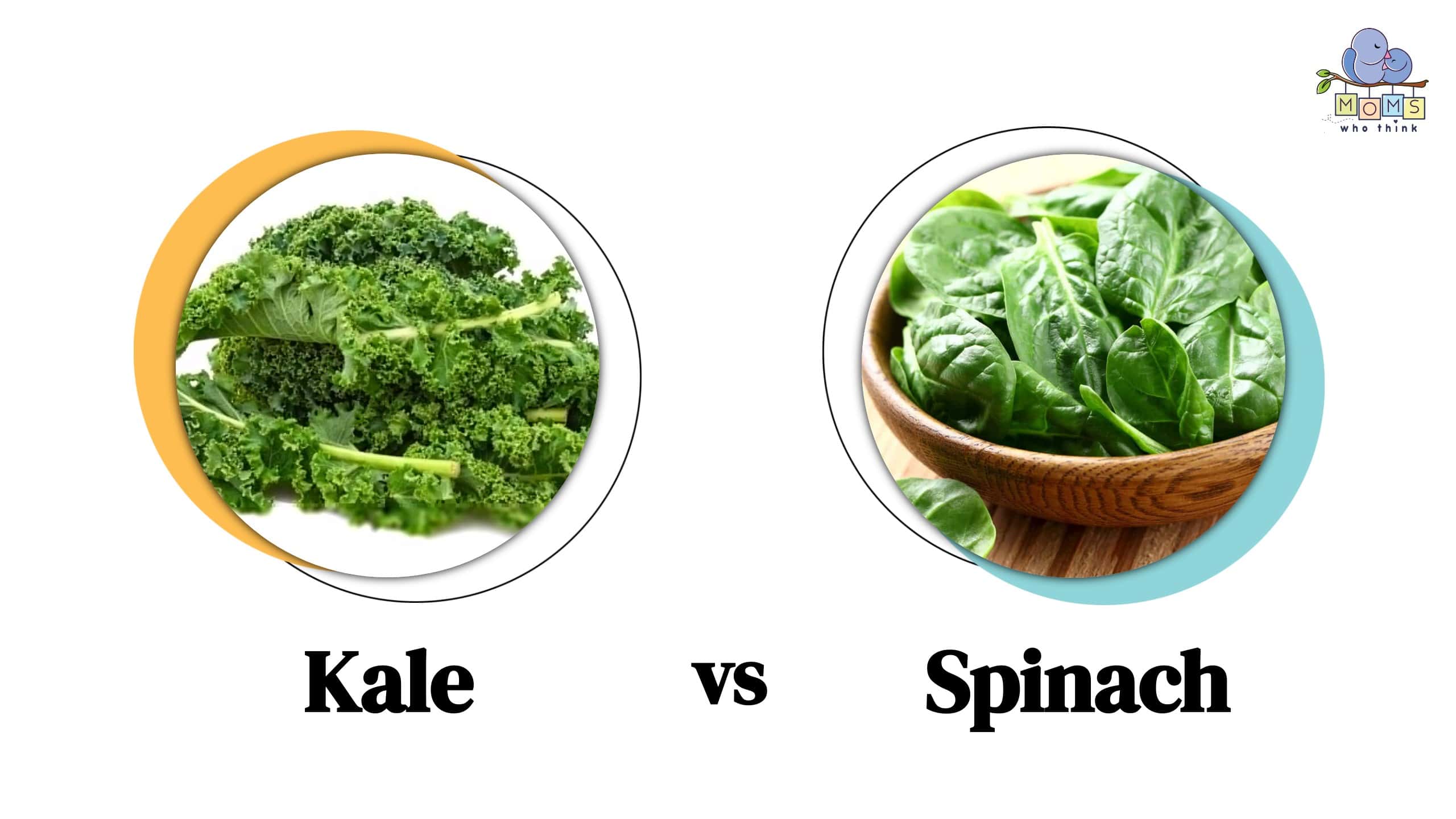Kale and spinach are great choices for healthy vegetable options for your family. And while they share similarities – there are key differences. Kale has a stronger, slightly bitter taste than spinach. It’s richer and has more nutrient-dense vitamins and minerals than spinach. On the other hand, spinach contains slightly more fiber than kale does. What option is best for you and your family? Let’s dig into kale vs. spinach and see the best way to use these superfoods!
Kale vs. Spinach: What Are the Differences?
Texture and Taste
Kale has a robust and slightly bitter flavor. Some people find the taste to be a bit overpowering. But there are different types of kale, and each brings their own level of intensity when it comes to the flavor. For example, curly kale has a stronger flavor. Whereas lacinto or dinosaur kale has a milder flavor. All in all, kale leaves are quite sturdy and have a coarse texture. Think of them like the armor-clad warriors of the leafy greens world.
In terms of reducing the intense flavor, here’s one approach you can take: If you use kale in salads, try massaging the kale with your fingers while allowing the liquid, such as oil or vinegar to absorb into the greens. That way it will produce a milder and more tender kale. And it also makes it taste better!

©Elena Veselova/Shutterstock.com
On the other hand, spinach is milder right from the start! It also has an overall sweeter taste. The flavor is more of a delicate nature and is less bitter compared to kale. This may explain why most prefer spinach as a favorite over kale! Spinach also has a variety of leaves that impact their flavors. For example, the smaller spinach leaves, known as baby spinach, are tender with a sweeter flavor more than the larger, mature leaves.
Cooking
There are many techniques to soften the kale leaves while enhancing the flavor. For example, you can sauté kale with a touch of olive oil and garlic to help tame the bitter taste. But don’t worry – you can still enjoy the crunchiness too! For example, you can bake kale into crispy chips. It’s a great way to enjoy a super easy and healthy snack for your family! And if you’re in the mood for a healthy, energy-boosting smoothie that’s chockful of nutrients, then you can blend kale leaves with fruits. It’s a great way to start the day and get the kids off to a healthy morning!
Spinach is super easy and versatile to cook with. Why? Because the spinach leaves wilt quickly when heated. So you don’t need to spend lots of time in the kitchen cooking them. They are great additions to stir-fries, pasta dishes, soups and salads. In fact, you can enjoy spinach raw in salads. The leaves are tender just enough to provide a refreshing crunch in every bite! It's also a go-to for omelets, quiches, and sandwiches too!
Kale vs. Spinach: Nutritional Value

What is Kale?
Kale is a dark green cruciferous vegetable that comes from Brassica oleracea. That’s just a fancy schmancy way to say it comes from the cabbage by way of the mustard family. It’s a cousin to brussel sprouts, broccoli and cauliflower. Kale’s leaves are either green or purple. The purple leaves contain a nutrient called anthocyanins which gives kale its color. This is the same nutrient found in berries like blueberries and cranberries. This nutrient has powerful antioxidant properties to help balance blood sugar, lengthen cell life, and keep you healthy!
Kale can harvest abundantly in the winter but usually no more less than 25 degrees fahrenheit. It also thrives in the spring and autumn.
What is Spinach?

©Dionisvera/Shutterstock.com
Spinach is a dark green leafy vegetable belonging to the Amaranth family. And surprisingly, it’s a cousin to quiona and beets. The leaves are of triangular shape and can have a flat or puckered look to it. They flourish and grow best in cool weather with deep rich soil. And even though it can withstand temperatures of ZERO degrees Fahrenheit, there’s no need to worry about the taste going bad! Why? Because it turns sweeter as the weather gets colder!
Best Kale Recipes
Best Spinach Recipes
Feta and Spinach Lasagna Rolls
Benefits of Using Kale and Spinach
When it comes to health benefits over kale vs. spinach, both are jam-packed with lots of health-boosting vitamins and minerals. Here are some benefits you get from eating kale and spinach:
Heart Health
Both Kale and spinach have key nutrients to boost heart health. For example, Vitamin K, acts as a blood-clotting nutrient. It’s super important because it helps to protect your blood vessels so they can maintain their flexibility and stay intact. Then there’s Vitamin C and Folate (Vitamin B9) that aids in fight cell damage so you can maintain healthy blood flow throughout your body.
And potassium and magnesium help to maintain healthy blood pressure levels while Vitamin A helps your heart function at its best.
Aids in Weight Loss
Kale and spinach are both low in calories but high in fiber content and important nutrients. How does this help with weight loss? Well it’s this kind of combo that can reduce the tendency to overeat. Fiber helps you feel fuller longer. These greens help regulate blood sugar levels, boost metabolism, and improve digestion. And because they are so low in calories, you add them to various dishes, guilt-free! So you can see how kale and spinach offer great support to maintaining a balanced diet and active lifestyle!
Immune Booster
Chockful of immune-boosting and infection-fighting vitamins like K, C and A, iron and antioxidants, here’s where kale and spinach are at their finest. Plus their fiber supports gut health which is super important for your immune system.
Eye Health
Rich in antioxidants such as lutein and zeaxanthin, these help protect your eyes from harmful
Influences. For example, they help sharpen focus, block harmful bright lights by acting as natural sunglasses and help reduce sensitivity to glare. In fact, Harvard University study found that women who ate spinach more than five times a week had a 47 percent decrease in risk of cataract surgery compared with those who ate spinach less than once a month. And lutein may also benefit eye health by reducing the risk of macular degeneration, according to the American Macular Degeneration Foundation.
Bone Health
Promotes healthy tissue growth. So when your little one has a cut or scrape, Vitamin C comes to the rescue! It also makes collagen, which is like the building block for your skin, cartilage, tendons and blood vessels.
Bottom Line
Famous for being the secret to Popeye’s legendary strength, spinach is truly a nutritional powerhouse. But so is Kale! Both are jam-packed with nutrients to help boost your immune system, regulate blood flow, maintain bone health, preserve cell health and help the cells in the body grow normally.
Final Thoughts
Kale vs. spinach, hmm? Both have their own unique charm when it comes to taste, texture, flavor, and cooking. For example, kale boasts a robust and slightly bitter taste, has strong leaves to stand up to cooking methods like sautéing and baking. On the other hand, spinach brings a gentle sweetness and tender texture, making it perfect for raw salads or quick-cooking dishes like stir-fries. All in all, the choice is up to you. And whatever you choose – you really can’t go wrong. Both kale and spinach are leafy green powerhouses, ready to add their special touch to your meals!

